FAQ - Advanced Bathroom Queries
What Happens if You Flush a Wet Wipe

Picture a tiny, harmless wet wipe beginning its perilous adventure through the winding complexities of our sewer systems.
Along the way, it encounters clogged pipes, overwhelmed wastewater treatment plants, and even health hazards.
This allegorical tale reveals the true impact of flushing wet wipes and the dire consequences it brings upon our infrastructure and environment.
Join us as we delve into the technical intricacies, economic burdens, and importance of proper wet wipe disposal.
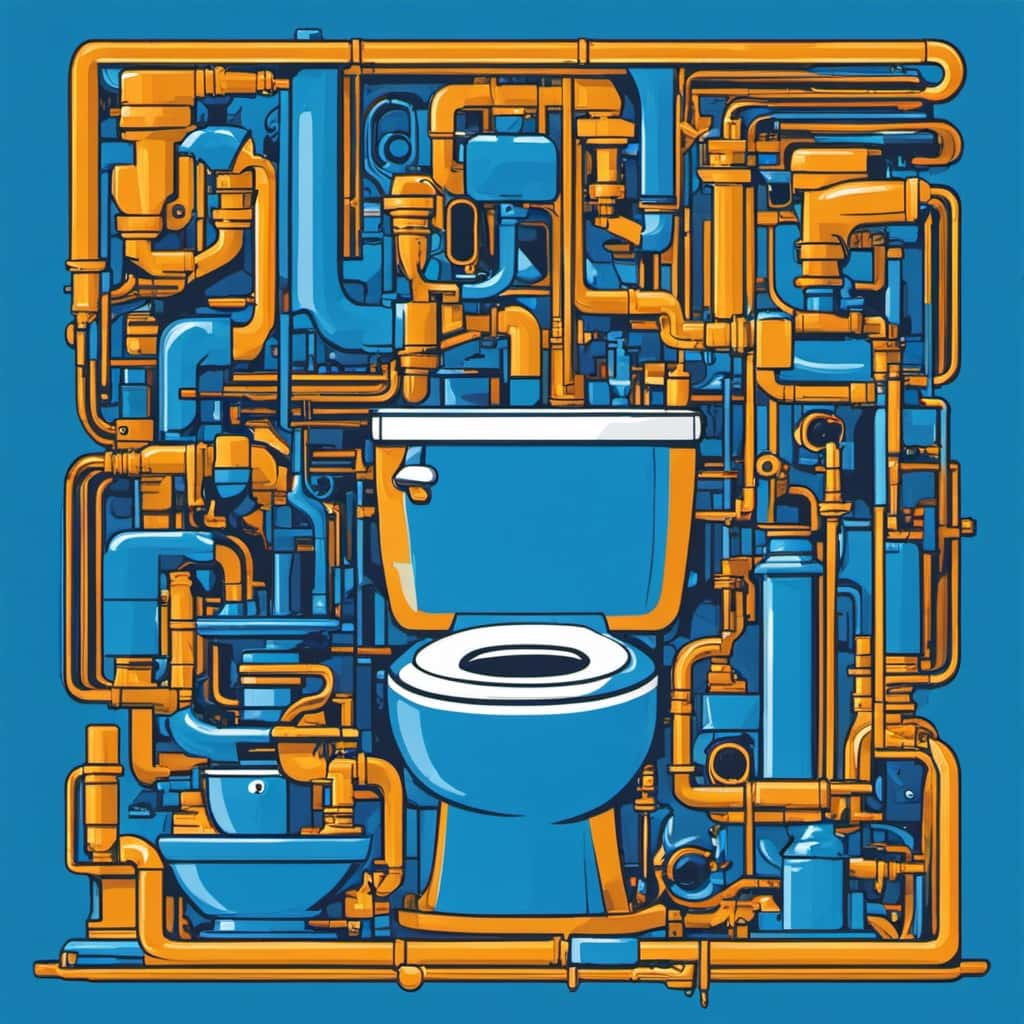
Mastery awaits those who seek knowledge in this realm.
Key Takeaways
- Flushing wet wipes can cause blockages in pipes, leading to sewer backups and overflows.
- Wet wipes can clog pumps and screens in wastewater treatment plants, causing restricted water flow and backups.
- Proper disposal of wet wipes in the trash is crucial to prevent damage to plumbing systems and sewage infrastructure.
- Wet wipes made of non-biodegradable materials contribute to microplastic pollution, harming aquatic organisms and ecosystems.
The Journey of a Flushed Wet Wipe
During the journey of a flushed wet wipe, it undergoes a series of transformations and encounters various obstacles.
Wet wipes are often mistakenly flushed down the toilet, leading to significant problems in the sewer system. Unlike toilet paper, wet wipes don’t disintegrate easily. Instead, they remain intact and can cause blockages in pipes, leading to sewer backups and overflows.
These blockages require costly repairs and can disrupt wastewater treatment plants. Wet wipes can clog pumps and screens, reducing their efficiency and increasing maintenance costs.

Furthermore, the impact of wet wipes on wastewater treatment plants is detrimental. They can cause equipment to malfunction and can even escape into water bodies, contributing to pollution.
It’s crucial to raise awareness about the proper disposal of wet wipes to prevent these issues and ensure the smooth functioning of our sewer system and wastewater treatment plants.
The Plumbing Nightmare of Wet Wipes
When it comes to wet wipes, the plumbing nightmare begins with clogging and blockages. These non-biodegradable wipes don’t break down like toilet paper, causing them to accumulate and create obstructions in the pipes.
As a result, water flow becomes restricted, leading to backups and potential sewage spills. Dealing with such plumbing issues can be a costly affair, often requiring professional intervention and expensive repairs.
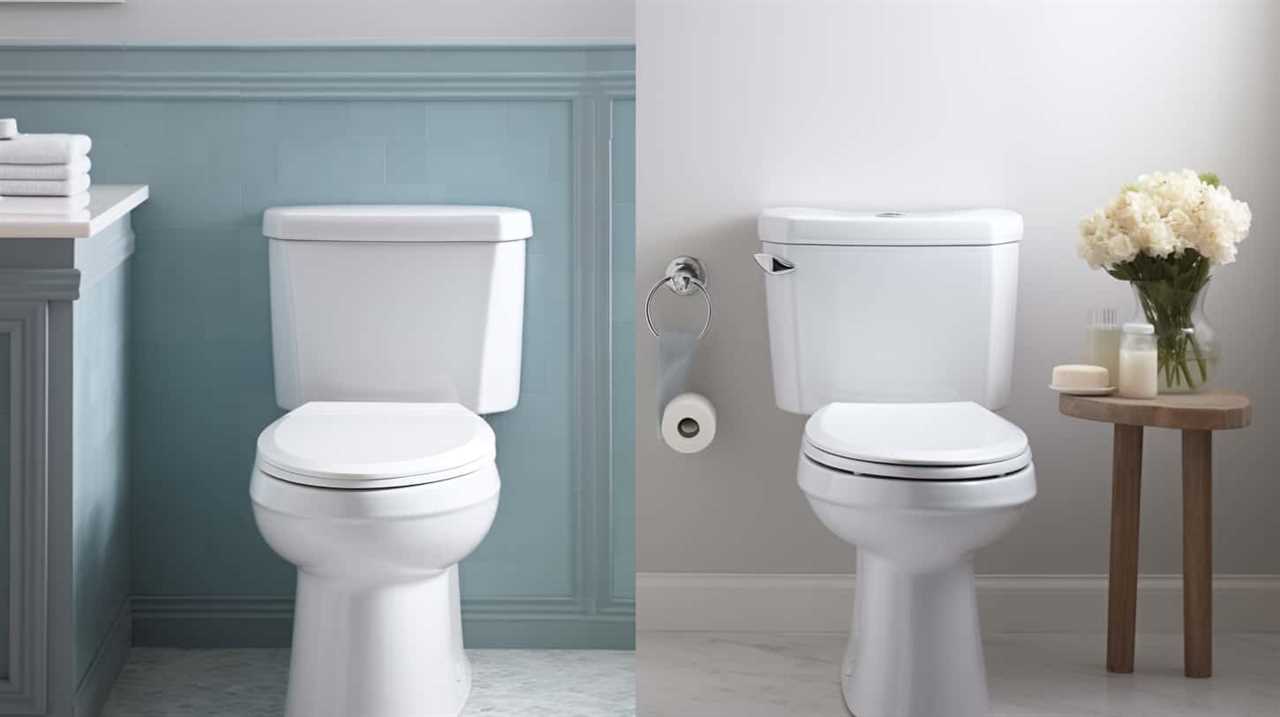
Clogging and Blockages
To understand the plumbing nightmare that wet wipes can cause, let’s delve into the consequences of flushing them down the toilet.
Wet wipes are notorious for clogging pipes and causing blockages in plumbing systems. These wipes aren’t designed to disintegrate like toilet paper, which makes them a major culprit in clogging prevention. When flushed, wet wipes can accumulate and clump together, forming large masses that obstruct the flow of wastewater. This can lead to backups, overflows, and costly repairs.
Additionally, wet wipes can have a detrimental impact on septic systems. The non-biodegradable materials in wet wipes can accumulate in the septic tank, reducing its capacity and efficiency. Over time, this can result in system failure and the need for expensive repairs.
It’s crucial to dispose of wet wipes in the trash to avoid these plumbing nightmares.
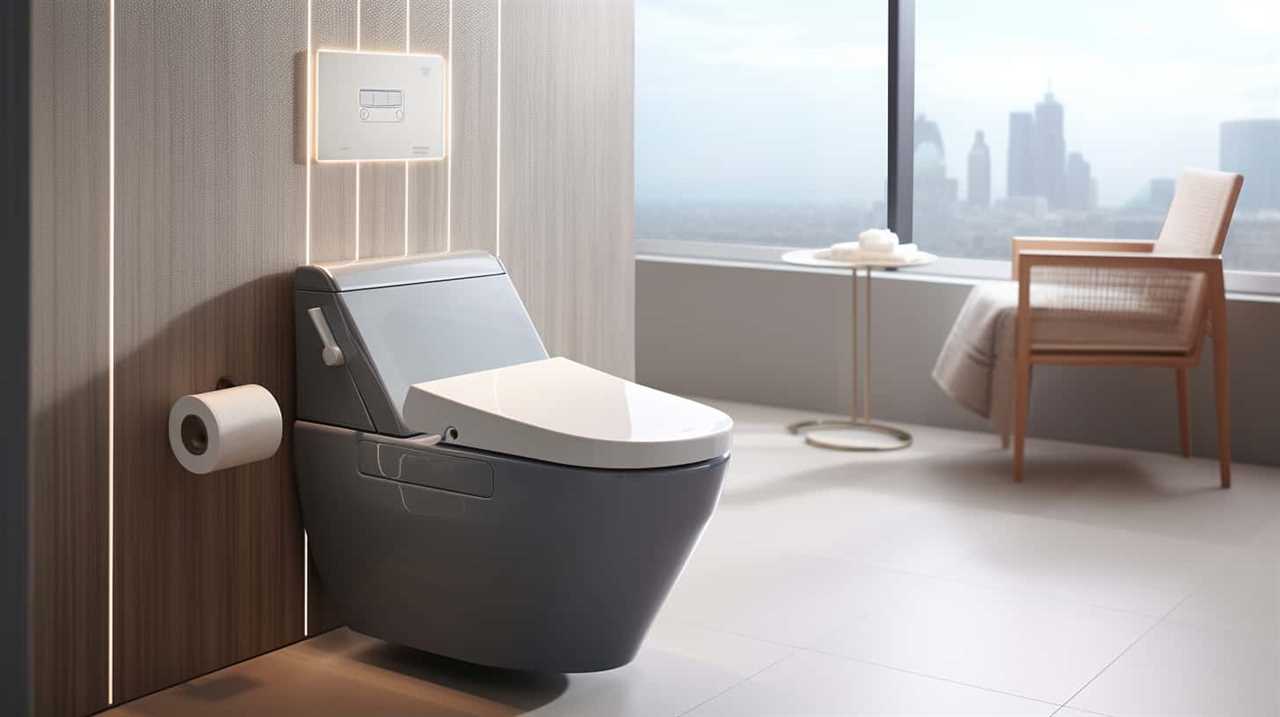
Expensive Plumbing Repairs
Moving on to the costly consequences of flushing wet wipes, we encounter the plumbing nightmare of expensive repairs.
When wet wipes are flushed down the toilet, they can cause significant damage to the plumbing system, leading to costly repairs. Wet wipes aren’t designed to break down easily like toilet paper, and as a result, they can accumulate in the pipes and create clogs or blockages.
These clogs can restrict the flow of water and sewage, causing backups and overflows. Repairing the damage caused by wet wipes often requires the expertise of a professional plumber and can be a time-consuming and expensive process. In some cases, the entire plumbing system may need to be replaced, resulting in even higher costs.
To avoid this expensive nightmare, it’s essential to dispose of wet wipes properly, in designated trash bins.
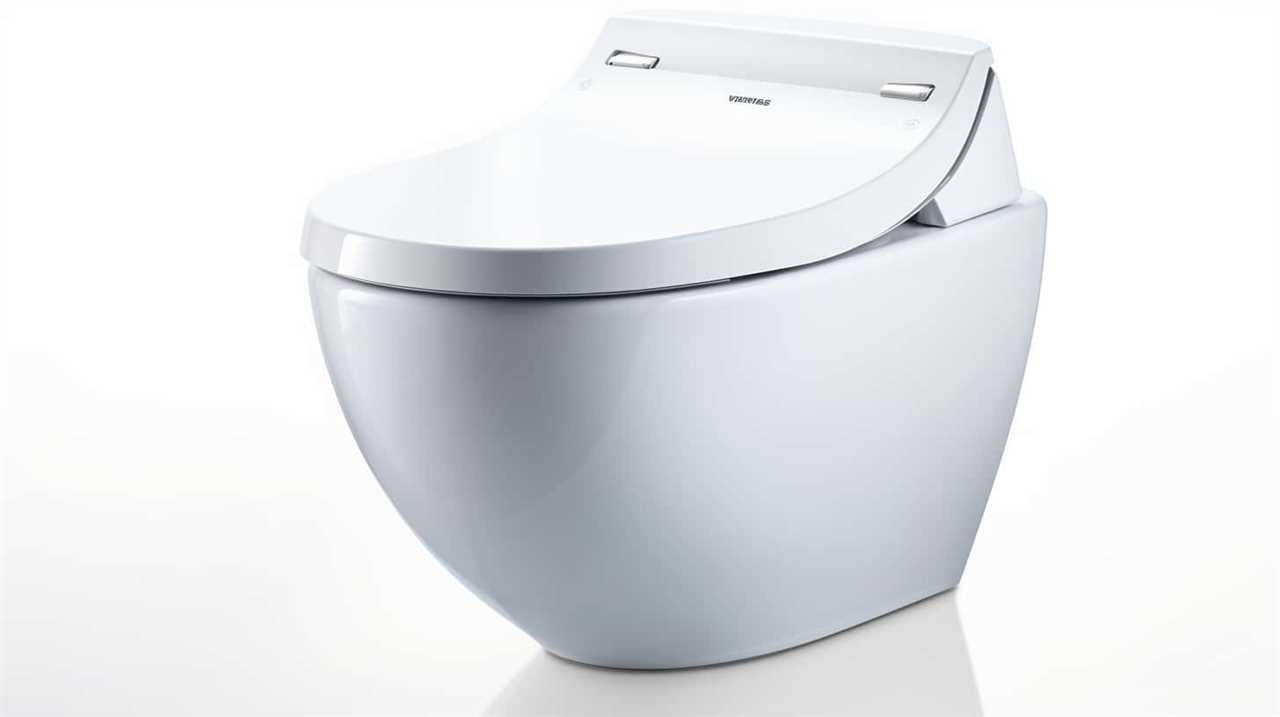
How Wet Wipes Affect Sewage Systems
When it comes to the impact of wet wipes on sewage systems, two major concerns arise: sewage system clogs and environmental impact.
Wet wipes, unlike toilet paper, don’t break down easily in water and can accumulate in sewage pipes, leading to blockages and backups.
Additionally, the plastics and chemicals in wet wipes can have detrimental effects on the environment when they make their way into water bodies, causing pollution and harm to aquatic life.
Sewage System Clogs
Flushing wet wipes causes clogging in sewage systems, leading to potential backups and costly repairs. Sewage system maintenance is crucial to prevent these issues and ensure the smooth operation of the system.
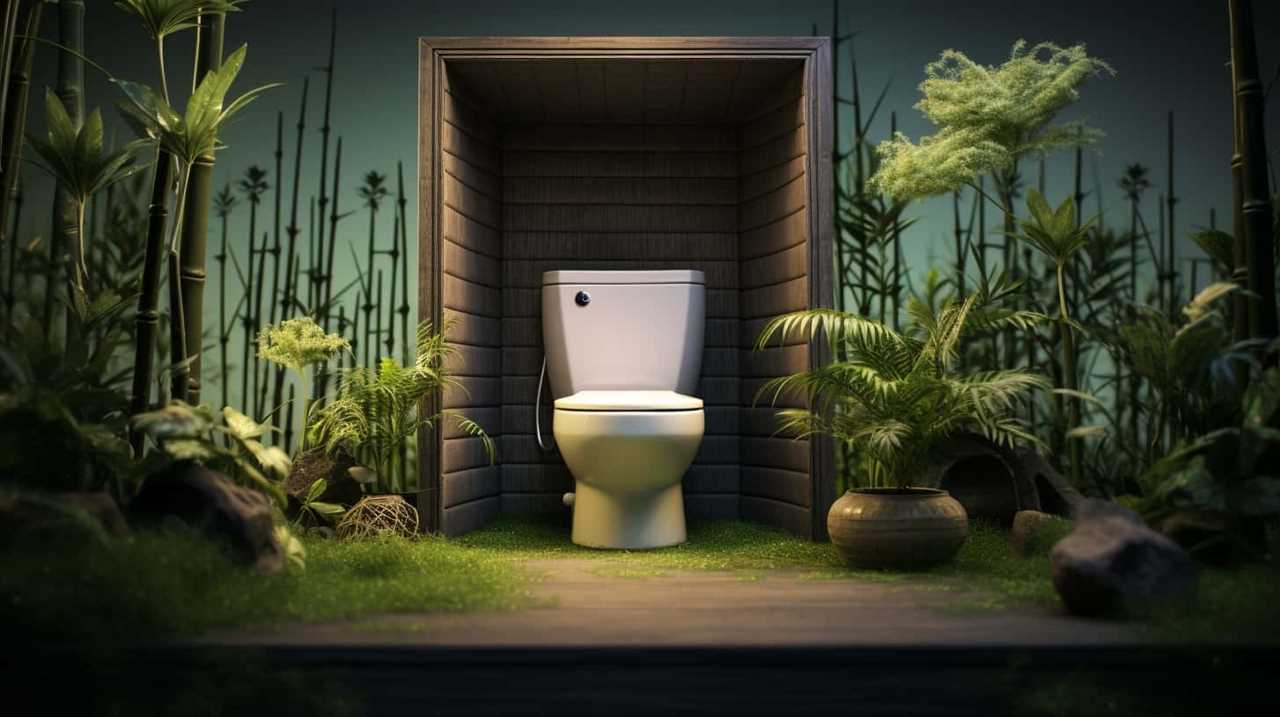
When wet wipes are flushed, they can accumulate and form blockages in the pipes. These blockages restrict the flow of wastewater, causing it to back up into homes, businesses, and streets. Additionally, wet wipes don’t break down easily like toilet paper, exacerbating the problem.
The impact on water quality is significant as well. Clogs in the sewage system can result in untreated wastewater being released into the environment, contaminating water sources and harming aquatic life.
Therefore, it’s essential to educate the public about the proper disposal of wet wipes to mitigate these clogging issues and protect our sewage systems and water quality.
Environmental Impact Concerns
As we delve into the environmental impact concerns of wet wipes on sewage systems, it becomes apparent that these non-biodegradable items pose a significant threat to the proper functioning and overall health of our wastewater infrastructure. Wet wipes, unlike toilet paper, do not break down easily and can cause blockages in sewage pipes and treatment plants. This leads to increased maintenance costs and potential disruptions in the sewage system. Additionally, the decomposition of wet wipes releases microplastics into the water, which can have detrimental effects on marine ecosystems. These tiny plastic particles can be ingested by marine organisms, leading to bioaccumulation and potential harm to the entire food chain. It is crucial that we raise awareness about the negative impact of flushing wet wipes and encourage the use of more environmentally friendly alternatives.
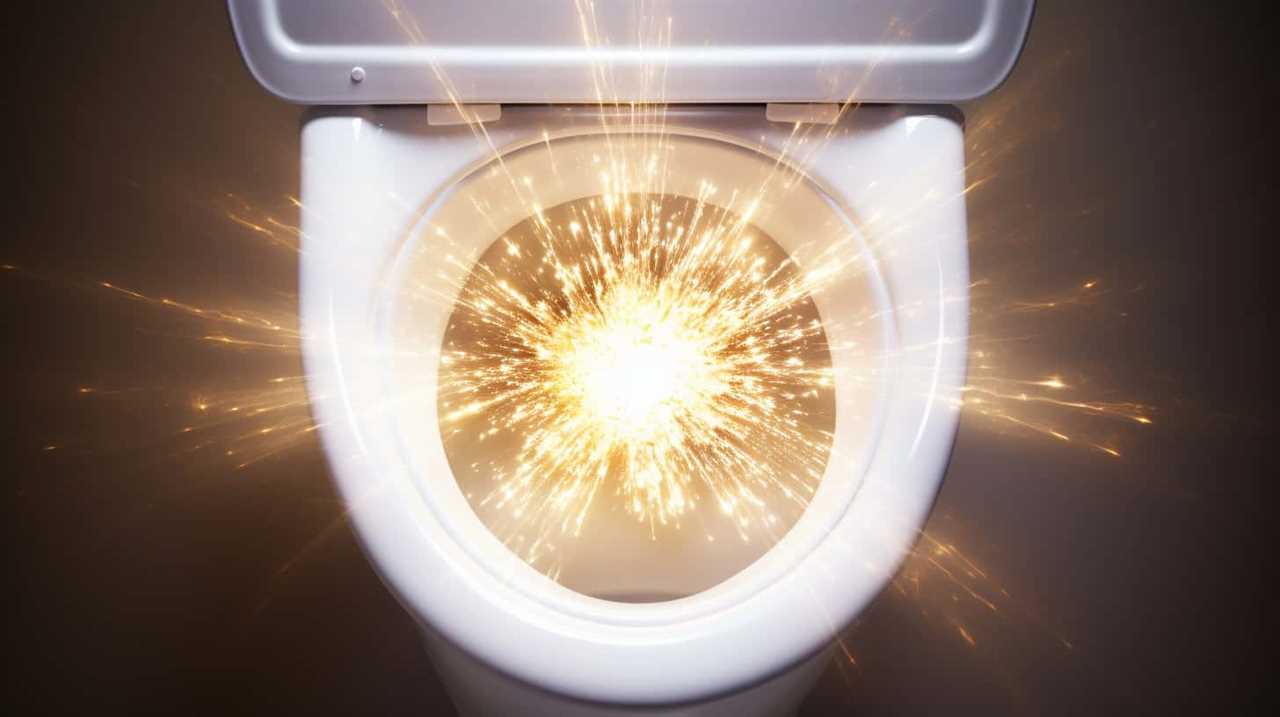
| Environmental Impact Concerns of Wet Wipes | ||
| Impact | Description | Solution |
| Wet wipe decomposition | Wet wipes do not break down easily in sewage systems, leading to blockages and increased maintenance costs. | Encourage the use of biodegradable wet wipes or dispose of them in the trash. |
| Impact on marine ecosystems | The decomposition of wet wipes releases microplastics, which can harm marine organisms and disrupt the food chain. | Raise awareness about the negative effects of flushing wet wipes and promote the use of sustainable alternatives. |
Impact on Wastewater Treatment Plants
Our wet wipes can have a significant impact on wastewater treatment plants. When flushed down the toilet, these non-biodegradable wipes enter the sewage treatment system and disrupt the delicate balance of wastewater management.
The problem lies in the fact that wet wipes don’t break down easily like toilet paper. Instead, they can clog pipes and pumps, causing blockages and equipment malfunctions. This leads to increased maintenance costs and reduced efficiency in wastewater treatment plants.
Furthermore, the presence of wet wipes in the treatment process can interfere with the biological treatment methods used to remove pollutants from the water. As a result, the overall effectiveness of sewage treatment is compromised.
Now, let’s delve into the next section and explore the consequences of wet wipes clogging our pipes.
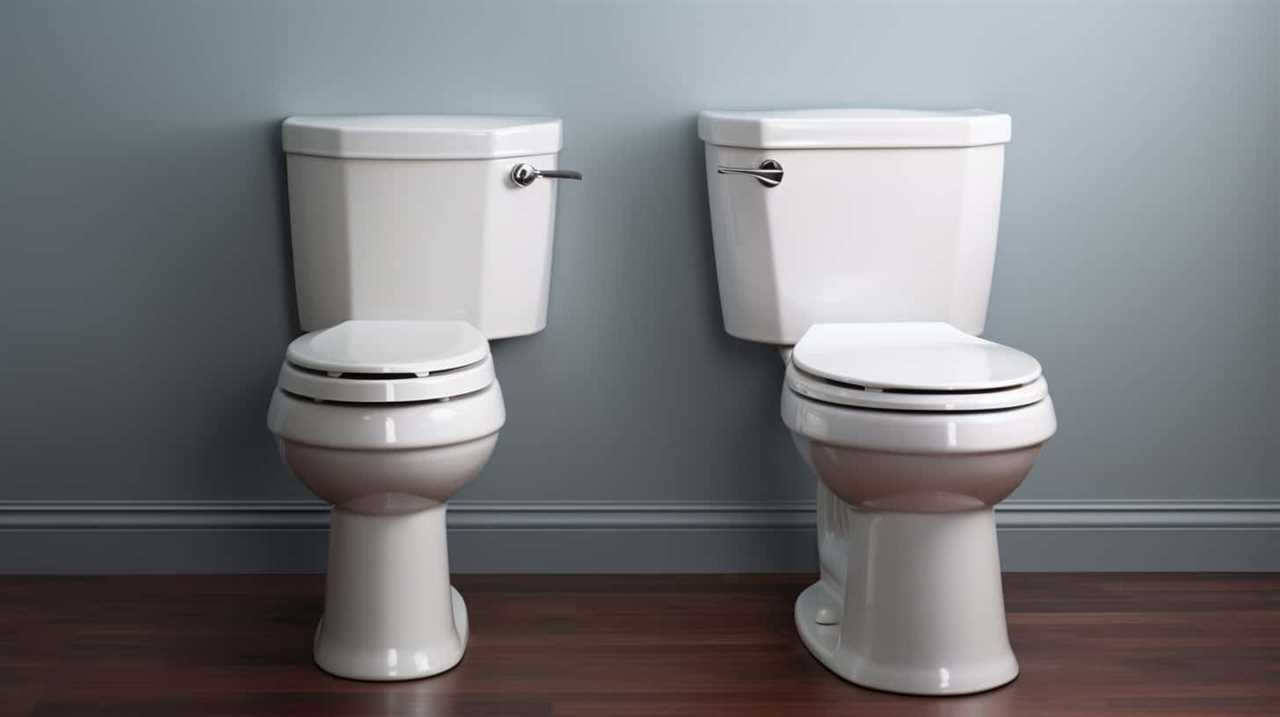
Wet Wipes and Clogged Pipes
When wet wipes are flushed down the toilet, they can lead to clogged pipes and cause significant issues in the sewage system. These clogs occur because wet wipes do not break down as easily as toilet paper, causing them to accumulate and form blockages. This not only affects individual plumbing systems but also poses a threat to the entire wastewater treatment process. To understand the dangers of flushing wet wipes, let’s take a closer look at the impact on wastewater treatment facilities.
| Dangers of Flushing Wet Wipes | Impact on Wastewater Treatment Facilities |
|---|---|
| Clogged pipes and blockages | Increased maintenance and repair costs |
| Reduced flow capacity | Higher energy consumption |
| Increased risk of sewage backups | Decreased efficiency in removing pollutants |
| Damage to equipment | Potential for environmental contamination |
| Increased risk of sewer overflows | Impact on water quality |
The dangers of flushing wet wipes not only disrupt the proper functioning of sewage systems but also impact the overall efficiency and effectiveness of wastewater treatment facilities. As a result, it is crucial to address this issue to prevent further harm to the environment and ensure the proper treatment of wastewater.
The Environmental Consequences of Flushing Wet Wipes
The improper disposal of wet wipes can have detrimental environmental consequences, exacerbating pollution and compromising ecosystem health. When wet wipes are flushed down the toilet, they enter the wastewater system and can cause a range of issues.
The environmental consequences of flushing wet wipes include:
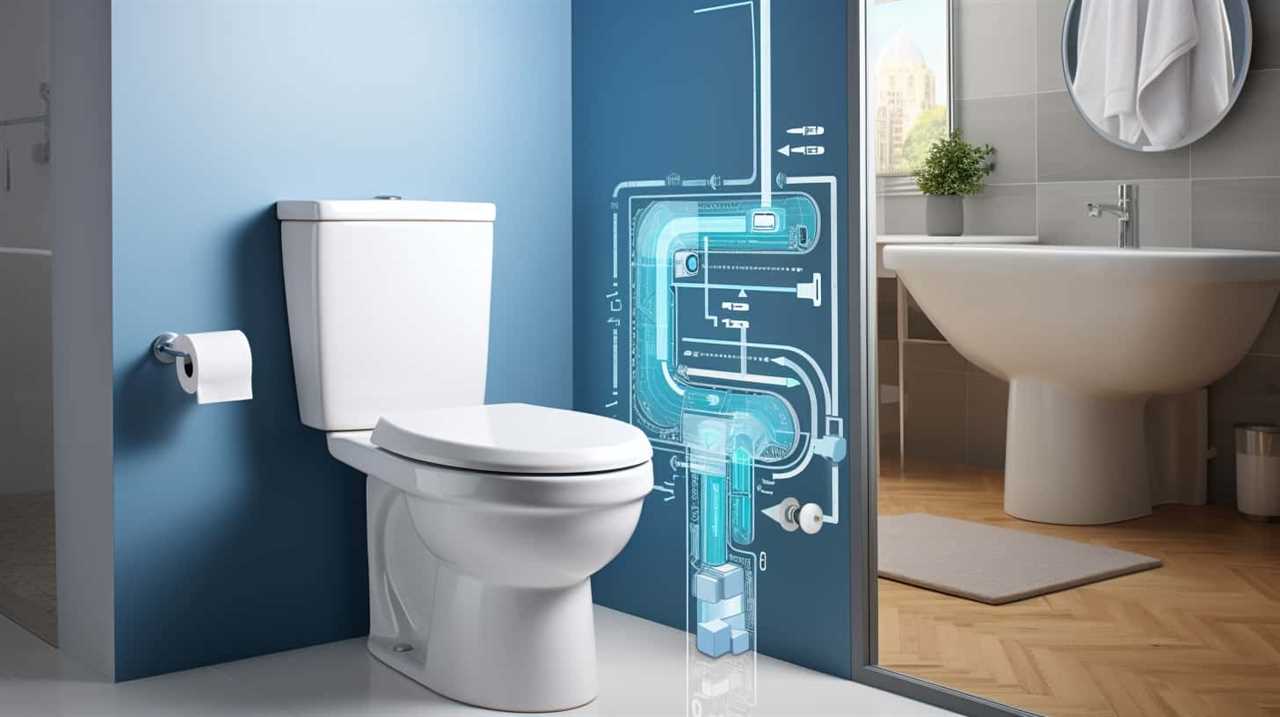
- Microplastic pollution: Wet wipes are often made of synthetic materials like polyester or polypropylene, which don’t biodegrade easily. When they break down in the water, they release microplastics, tiny particles that can contaminate water bodies and harm aquatic organisms.
- Health hazards: Wet wipes can contain chemicals and additives that are harmful to both humans and wildlife. These substances can leach into the environment, polluting water sources and posing risks to the health of organisms that come into contact with them.
It is crucial to properly dispose of wet wipes in the trash to minimize these environmental consequences and protect our ecosystems.
Wet Wipe Pollution in Oceans and Rivers
When it comes to wet wipe pollution in oceans and rivers, the environmental impact can’t be ignored. These wipes, often made of non-biodegradable materials, contribute to the growing problem of marine pollution.
Finding solutions for reducing this pollution is crucial, as it not only affects the cleanliness of our waterways but also has detrimental effects on marine life.
Environmental Impact of Wet Wipes
Wet wipes pose a significant threat to the environment, as they contribute to the pollution of oceans and rivers. The impact on ecosystems is devastating, as these wipes don’t break down like toilet paper and instead accumulate in bodies of water. This pollution harms marine life, as animals can mistake the wipes for food and suffer from ingestion or entanglement.
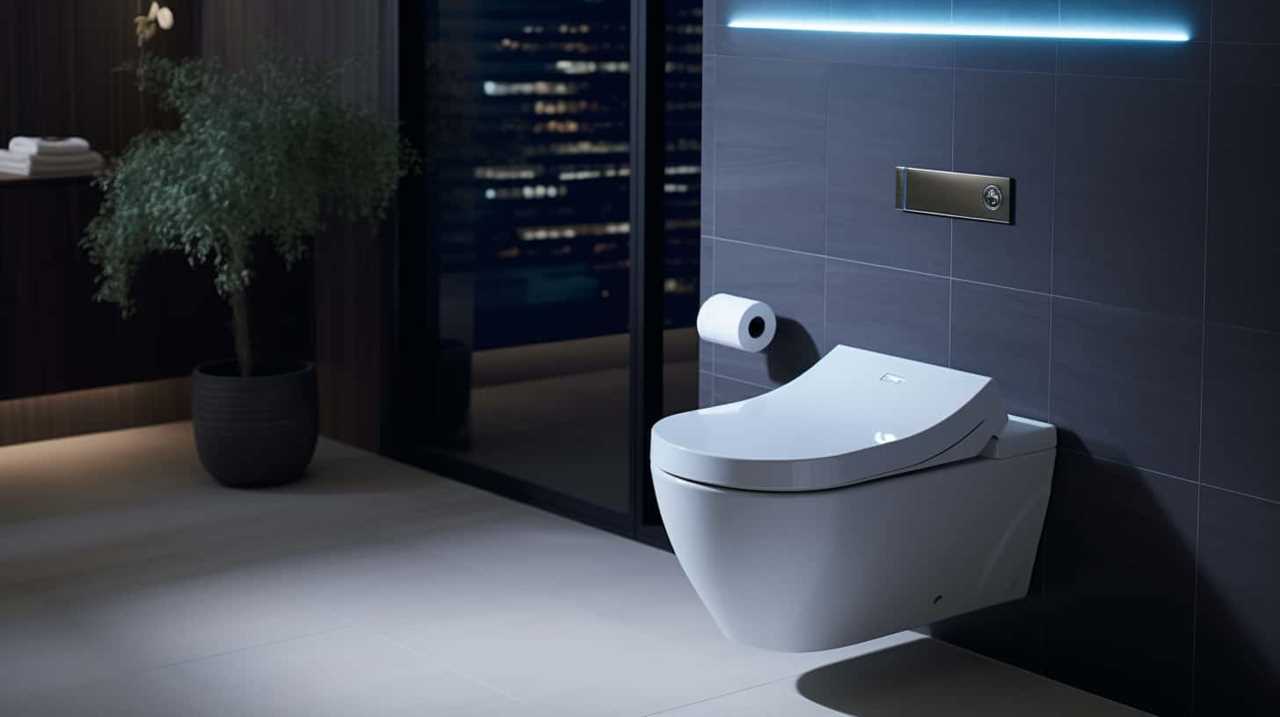
Additionally, wet wipes contain non-biodegradable materials, such as plastic fibers, which further exacerbate the pollution problem. Despite the detrimental effects, public awareness about the environmental consequences of wet wipes remains low. People often don’t realize the long-term damage caused by flushing these wipes down the toilet.
However, it’s crucial to educate the public about the harm they’re causing to our ecosystems and promote more sustainable alternatives. Transitioning into the subsequent section, we’ll explore solutions for reducing wet wipe pollution.
Solutions for Reducing Pollution
To address the issue of wet wipe pollution in oceans and rivers, we can implement a number of effective solutions.
One solution is to promote the use of reusable alternatives to wet wipes. By encouraging individuals to switch to reusable cloths or towels, we can reduce the demand for single-use wet wipes and decrease the amount of waste that ends up in our waterways.

In addition to promoting reusable alternatives, government regulations can play a crucial role in reducing wet wipe pollution. Governments can impose stricter regulations on the labeling and disposal of wet wipes, as well as incentivize manufacturers to produce more eco-friendly alternatives.
By implementing these solutions, we can take significant steps towards mitigating the pollution caused by wet wipes in our oceans and rivers.
Transitioning into the subsequent section about the effects on marine life, it’s important to understand the devastating consequences that wet wipe pollution can have on aquatic ecosystems.
Effects on Marine Life
As we delve into the issue of wet wipe pollution in oceans and rivers, it becomes apparent that the effects on marine life are both far-reaching and concerning. The presence of wet wipes in these bodies of water contributes to the growing problem of microplastic pollution, which poses significant threats to marine ecosystems. The long-term ecosystem damage caused by wet wipe pollution is a cause for alarm.
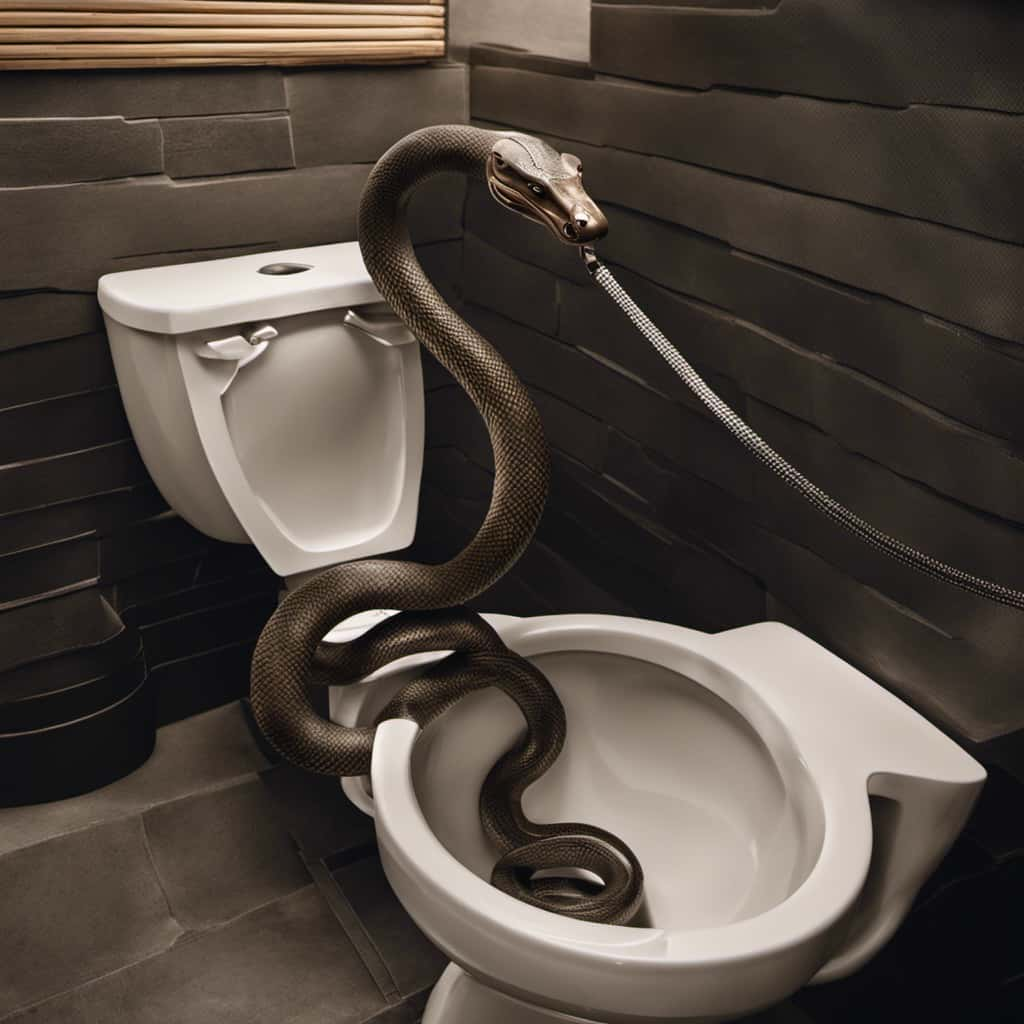
Here are the key effects on marine life:
- Physical harm: Marine animals such as fish, turtles, and seabirds often mistake wet wipes for food, leading to ingestion and potential intestinal blockages.
- Habitat disruption: Wet wipes can accumulate in coral reefs, seagrass beds, and other important habitats, altering the delicate balance and biodiversity of these ecosystems.
These impacts on marine life highlight the urgent need to address wet wipe pollution and its consequences.
Transitioning into the subsequent section, let’s now explore the hidden cost of flushing wet wipes.
The Hidden Cost of Flushing Wet Wipes
Flushing wet wipes comes with a hidden cost that we often overlook. While wet wipes may seem convenient for personal hygiene or household cleaning, the repercussions of flushing them down the toilet can be significant. Not only do wet wipes pose hidden dangers to our plumbing systems, but they also have serious cost implications for our society and environment.

To truly grasp the extent of the hidden cost, let’s take a look at the following table:
| Hidden Dangers | Cost Implications |
|---|---|
| Clogged Pipes | Expensive Repairs |
| Sewage Blockages | Increased Maintenance Costs |
| Environmental Pollution | Water Treatment Expenses |
As the table illustrates, flushing wet wipes can lead to clogged pipes, resulting in expensive repairs. Sewage blockages incur increased maintenance costs for municipalities, while the environmental pollution caused by these non-biodegradable wipes leads to additional expenses in water treatment.
Understanding the hidden dangers and cost implications of flushing wet wipes is crucial in addressing the subsequent section about the risks to marine life from flushed wet wipes.
Risks to Marine Life From Flushed Wet Wipes
When it comes to the impact of flushed wet wipes on marine life, we need to consider the potential risks they pose. Marine pollution is a serious concern, and wet wipes contribute to this problem by entering the waterways and oceans. The following are the risks that flushed wet wipes pose to marine life:
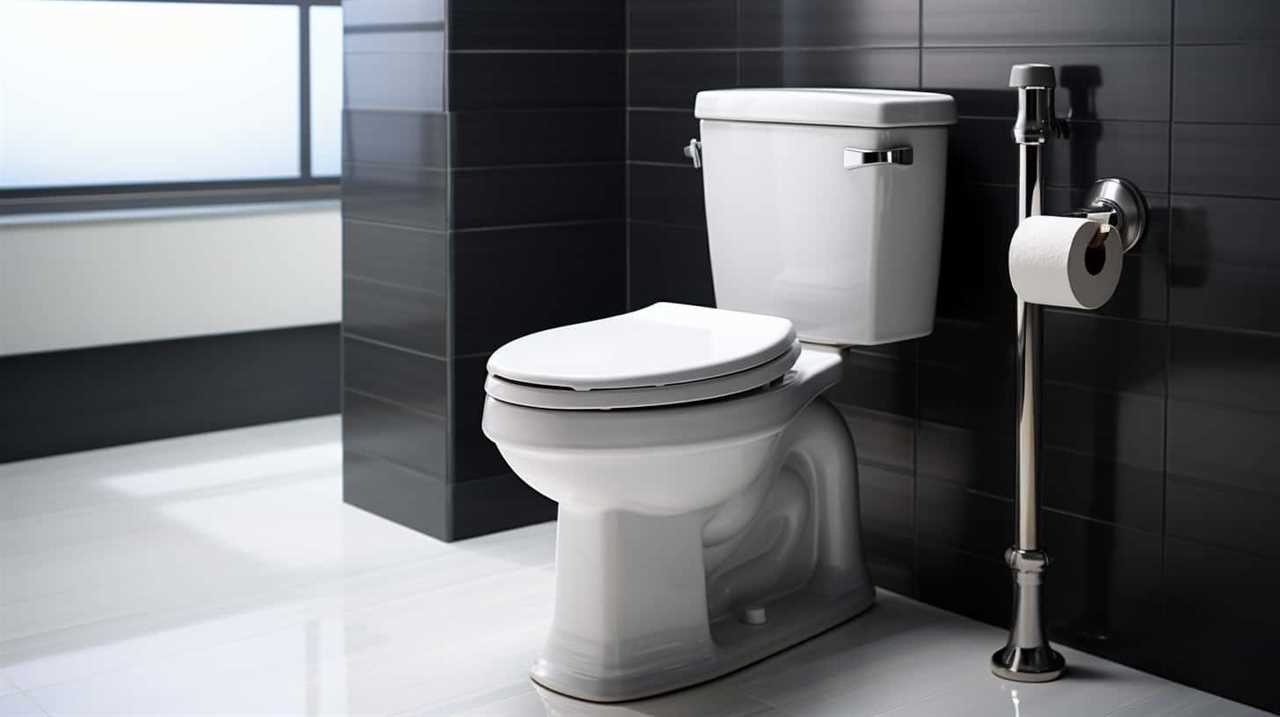
- Entanglement: Marine animals such as turtles, seals, and dolphins can become entangled in wet wipes, leading to injury or death.
- Ingestion: Marine organisms may mistake wet wipes for food and consume them, leading to digestive tract blockages or internal injuries.
To mitigate these risks, it’s crucial to raise awareness about proper disposal methods and the importance of not flushing wet wipes down the toilet. Additionally, improvements in wastewater treatment processes should be made to effectively remove wet wipes and other pollutants from the water before it reaches the marine environment.
In the next section, we’ll delve into the connection between wet wipes and microplastic pollution.
Wet Wipes and Microplastic Pollution
When it comes to wet wipes, there’s a growing concern about their environmental impact, particularly in relation to microplastic pollution. These wipes are often made of synthetic materials that don’t biodegrade easily, leading to the release of microplastics into our waterways. These tiny plastic particles can have detrimental effects on marine life and ecosystems.
However, there are solutions available to reduce this pollution, such as using biodegradable alternatives or properly disposing of wet wipes in the trash.
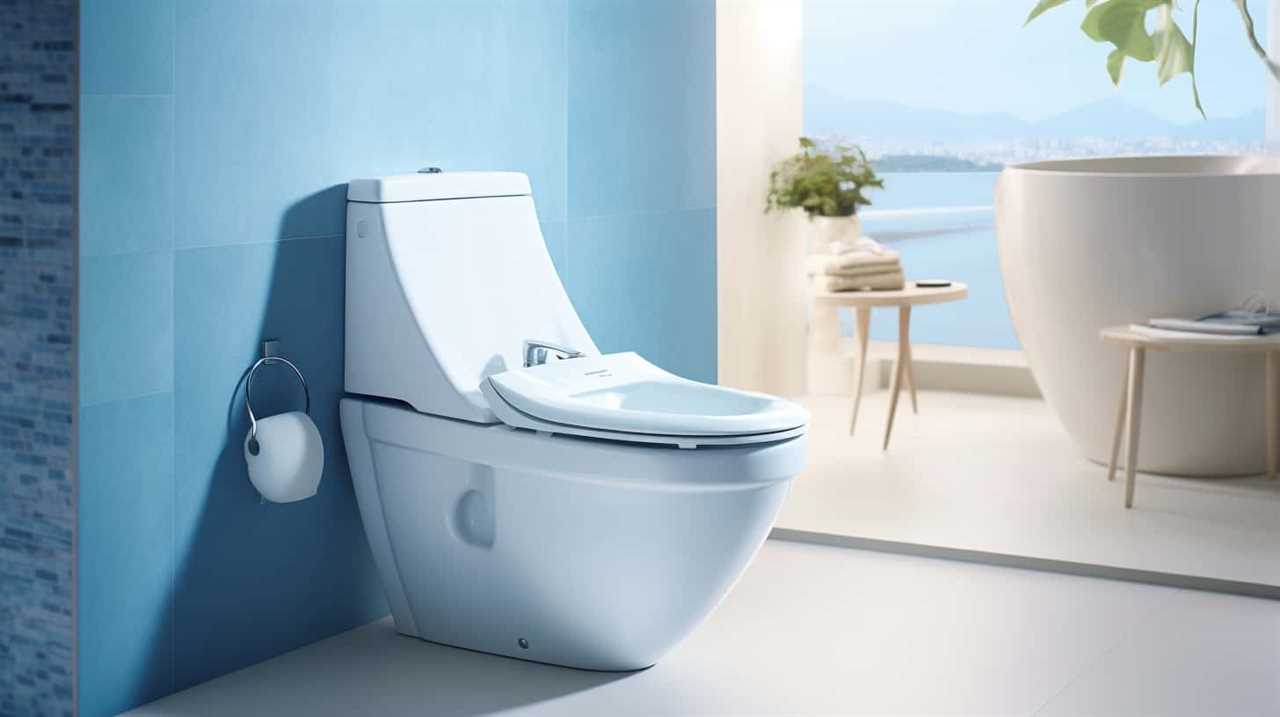
Environmental Impact of Wet Wipes
After being flushed, wet wipes contribute to the environmental impact by releasing microplastics into water systems. These microplastics are a major concern because they’re small enough to be ingested by marine organisms, leading to potential harm to aquatic life and the overall ecosystem.
The environmental impact of wet wipes extends beyond their disposal. The manufacturing process of wet wipes also contributes to the problem. Key points to consider include:
- Reusable Alternatives:
- Encouraging the use of reusable alternatives, such as washable cloths or biodegradable wipes, can significantly reduce the environmental impact.
- These alternatives not only eliminate the need for single-use wet wipes but also minimize the release of microplastics into water systems.
- Wet Wipe Manufacturing Process:
- The production of wet wipes involves the use of non-biodegradable materials like polyester and polypropylene.
- These materials can take hundreds of years to decompose, adding to the accumulation of microplastics in the environment.
Solutions for Reducing Pollution
To address the issue of wet wipe and microplastic pollution, we can implement solutions that focus on reducing their usage and promoting environmentally-friendly alternatives. One solution is to raise awareness among consumers about the negative impacts of wet wipes on the environment. By educating the public about the importance of sustainable alternatives, such as reusable cloth wipes or biodegradable options, we can encourage individuals to make more conscious choices. Another solution involves implementing government regulations to limit the production and sale of non-biodegradable wet wipes. These regulations can also require manufacturers to provide clear labeling about the environmental impact of their products. Additionally, investing in research and development of innovative technologies that can break down microplastics in wastewater treatment plants can help mitigate the pollution caused by wet wipes.
| Solution | Description | Benefits |
|---|---|---|
| Raise awareness | Educating the public about the negative impacts of wet wipes on the environment | Encourages individuals to make more sustainable choices |
| Government regulations | Implementing rules to limit the production and sale of non-biodegradable wet wipes | Ensures compliance and reduces the availability of harmful products |
| Research and development of | Investing in technologies that can break down microplastics in wastewater treatment plants | Helps mitigate the pollution caused by wet wipes and reduces the impact on aquatic ecosystems |
Health Hazards Associated With Flushed Wet Wipes
One of the health hazards associated with flushed wet wipes is the increased risk of clogged pipes. When wet wipes are flushed down the toilet, they don’t break down like toilet paper does. Instead, they can accumulate and form blockages in the pipes. This can lead to sewage backups and overflows, causing damage to homes and the environment.

The impact on water quality is another concern. Wet wipes contain various chemicals and synthetic materials that can contaminate water bodies when they’re flushed. These pollutants can harm aquatic life and disrupt ecosystems. In addition, the presence of wet wipes in water bodies can create breeding grounds for bacteria, increasing the risk of waterborne diseases.
To summarize the health risks associated with flushed wet wipes:
- Increased risk of clogged pipes
- Potential damage to homes and the environment
- Impact on water quality
- Contamination of water bodies
- Disruption of ecosystems
- Increased risk of waterborne diseases
It is crucial to properly dispose of wet wipes in the trash to avoid these health hazards and protect our environment.
The Economic Burden of Wet Wipe Disposal
The economic burden of wet wipe disposal is a significant concern for communities and municipalities. The improper disposal of wet wipes can lead to clogged pipes, sewer backups, and increased maintenance costs for wastewater treatment facilities.

The economic impact of these issues is twofold. Firstly, the cost of repairing and replacing damaged infrastructure can be substantial. Secondly, the expenses associated with waste management, including the removal and treatment of wet wipes, can place a strain on local budgets.
Municipalities often bear the financial responsibility of addressing these challenges, which can divert funds from other essential services. To mitigate this economic burden, it’s crucial to educate the public about proper disposal methods and invest in improved waste management systems.
Alternatives to Flushing Wet Wipes
Instead of flushing wet wipes, we can consider more environmentally-friendly options for their disposal. Here are some eco-friendly options and reusable alternatives to help mitigate the negative impact of wet wipes on the environment:
- Eco-friendly options:
- Dispose of wet wipes in the trash: Seal them in a plastic bag before throwing them away to prevent odors.
- Use biodegradable wipes: Look for wipes made from natural and biodegradable materials that can break down over time.
- Reusable alternatives:
- Cloth wipes: Invest in reusable cloth wipes made from soft and absorbent materials that can be washed and reused.
- Bidets or wetting cloths: Consider using bidets or wetting cloths instead of wet wipes for personal hygiene.
The Importance of Proper Wet Wipe Disposal
To properly dispose of wet wipes, we must recognize the importance of responsible waste management. Improper disposal of wet wipes can have severe environmental consequences. When flushed down the toilet, they can clog pipes and cause blockages in sewage systems. This can lead to costly repairs and backups, which can result in the release of untreated sewage into waterways.
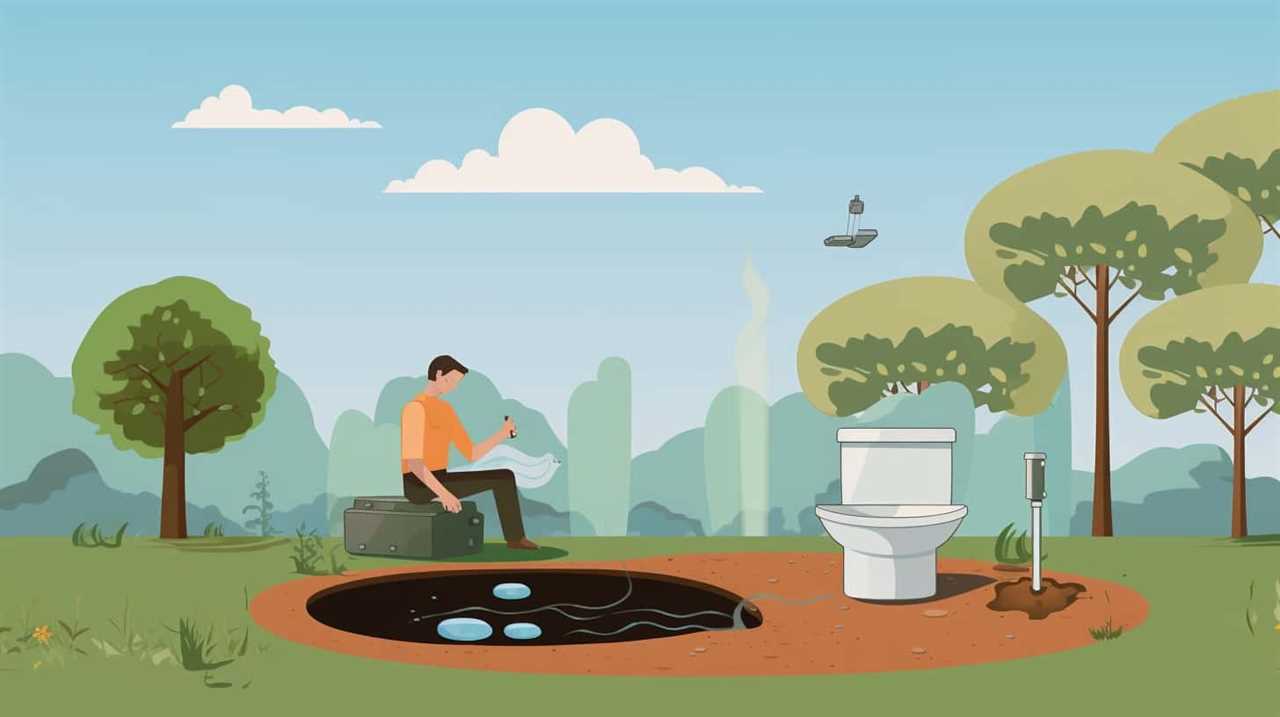
Wet wipes aren’t biodegradable like toilet paper, and they can take years to break down, contributing to the growing problem of plastic pollution in our oceans and landfills. Proper wet wipe disposal involves throwing them in the trash after use, preferably in a sealed bag to prevent any odors or leakage.
Conclusion
In conclusion, flushing wet wipes down the toilet may seem harmless, but it creates a hidden journey of destruction.
These innocent-looking wipes can wreak havoc on our plumbing systems, causing blockages and costly repairs. Not only do they clog pipes, but they also pose health hazards and burden wastewater treatment plants.
It’s crucial to educate ourselves on proper wet wipe disposal and consider alternative options to protect our environment and prevent future plumbing nightmares.

Let’s break free from the chains of flushed wet wipes and embrace responsible waste management.
With an impeccable eye for detail and a passion for bathroom-related, Ava leads our editorial team gracefully and precisely.
Under her guidance, Best Modern Toilet has flourished as the go-to resource for modern bathroom enthusiasts. In her free time, you might find Ava exploring antique shops and looking for vintage bathroom fixtures to add to her collection.
FAQ - Advanced Bathroom Queries
Can You Flush the Toilet Paper in Italy

Have you ever wondered if it’s okay to flush toilet paper in Italy? Here’s the lowdown: plumbing practices in Italy may vary from what you’re used to.
We’ve all experienced those moments of uncertainty in unfamiliar bathrooms, right? But fear not, because we’re here to shed some light on this cultural quirk.
In this article, we’ll explore the ins and outs of toilet paper disposal in Italy and offer some handy tips for navigating public restrooms like a pro.
So, let’s dive in!

Key Takeaways
- Italian plumbing systems are designed to handle the disposal of toilet paper without any issues.
- In many parts of Italy, the plumbing systems aren’t designed to handle toilet paper, so it is not flushed.
- Italians often dispose of used toilet paper in a waste bin next to the toilet instead of flushing it.
- Proper toilet paper disposal in Italy contributes to the preservation of the country’s historic buildings and protects the delicate plumbing infrastructure.
Plumbing System in Italy
In Italy, the plumbing system allows us to flush toilet paper down the toilet. This convenience isn’t only practical but also has important maintenance and environmental implications.
When it comes to maintenance, Italian plumbing systems are designed to handle the disposal of toilet paper without any issues. The pipes and sewer systems are built to efficiently transport and process waste, including toilet paper, preventing clogs and blockages. This is a testament to the advanced engineering and infrastructure in the country.
From an environmental perspective, allowing the flushing of toilet paper reduces the need for alternative disposal methods such as trash bins or separate waste systems. It also minimizes the risk of contamination and the spread of bacteria.
However, cultural differences in toilet paper disposal exist, which we’ll explore in the next section.

ARTICLE TRANSITION:
Now that we’ve discussed the plumbing system in Italy, let’s delve into the cultural differences in toilet paper disposal.
Cultural Differences in Toilet Paper Disposal
Let’s explore the cultural differences that exist when it comes to disposing of toilet paper in Italy. Toilet paper etiquette in Italy is quite different from what most of us are accustomed to.
- Do Not Flush: In many parts of Italy, the plumbing systems aren’t designed to handle toilet paper. Instead of flushing it down the toilet, Italians often dispose of used toilet paper in a waste bin next to the toilet.
- Bin Placement: It’s important to note that these waste bins are usually lined with plastic bags, which are replaced regularly to maintain cleanliness.
- Odor Control: To minimize any unpleasant smells, it’s common for Italians to use scented garbage bags and air fresheners in the bathroom.
Understanding these cultural differences in toilet paper disposal is crucial to avoid any plumbing mishaps during your visit to Italy.
Now, let’s explore some alternative methods of toilet paper disposal.

Alternative Methods of Toilet Paper Disposal
We can explore some alternative methods of toilet paper disposal in Italy. While flushing toilet paper is not the norm, there are sustainable options available. One popular method is using a bidet, which is a separate water basin used for cleaning oneself after using the toilet. Bidets are commonly found in Italian bathrooms and offer a hygienic and eco-friendly alternative to toilet paper. Another option is to use toilet paper specifically designed for disposal in waste bins, rather than flushing it. These specially-made toilet paper products are biodegradable and can be safely discarded in the bins provided. By utilizing these alternative methods, Italians are able to reduce their environmental impact while maintaining cleanliness. Speaking of cleanliness, let’s now move on to some tips for using public restrooms in Italy.
| Sustainable Options | Bidet Usage |
|---|---|
| Hygienic | Water-based |
| Eco-friendly | Reduces waste |
| Common in Italy | Alternative to toilet paper |
| Biodegradable | Clean and refreshing |
| Reduces environmental impact | Promotes personal hygiene |
Now that we’ve explored alternative methods of toilet paper disposal, let’s dive into some tips for using public restrooms in Italy.
Tips for Using Public Restrooms in Italy
Moving on to using public restrooms in Italy, there are a few tips that can help ensure a pleasant experience.
- Practice good hand hygiene: Always carry hand sanitizer or antibacterial wipes, as not all restrooms may have soap or paper towels available.
- Follow proper toilet etiquette: Italians are serious about keeping restrooms clean. It’s important to remember to not throw toilet paper into the toilet bowl, but instead, dispose of it in the waste bin provided.
- Be prepared for paid restrooms: Many public restrooms in Italy require a small fee for usage. It’s helpful to always carry some loose change to avoid any awkward situations.
Conclusion: Proper Toilet Paper Disposal in Italy
Continuing the conversation from the previous subtopic, we can delve into the proper disposal of toilet paper in Italy. When it comes to cultural implications, it is important to note that Italy has a different approach to toilet paper disposal compared to other countries. In most regions, it is customary to throw used toilet paper into a bin next to the toilet instead of flushing it down the toilet. This practice is rooted in the country’s older plumbing systems, which are not designed to handle large amounts of toilet paper.

This method of disposal may seem unusual to visitors, but it is essential to respect and abide by local customs. It is also worth considering the environmental impact of flushing toilet paper. By disposing of it in a bin, Italy reduces the strain on its sewage system and prevents potential blockages and costly repairs. Additionally, this practice contributes to the preservation of the country’s historic buildings, as it helps protect the delicate plumbing infrastructure.
To help you understand the proper toilet paper disposal in Italy, here is a simple table outlining the key differences compared to other countries:
| Country | Toilet Paper Disposal Method |
|---|---|
| Italy | Throw in a bin |
| United States | Flush down the toilet |
| United Kingdom | Flush down the toilet |
Frequently Asked Questions
Is the Plumbing System in Italy Similar to the Plumbing System in Other Countries?
Cultural differences affect plumbing systems worldwide. When comparing the plumbing system in Italy to others, it’s essential to consider factors like toilet paper disposal. Understanding these variations helps us navigate plumbing practices while traveling.
What Are Some Cultural Differences in Toilet Paper Disposal in Italy Compared to Other Countries?
Cultural practices vary when it comes to toilet paper disposal in Italy compared to other countries. It’s important to note that some places don’t allow flushing due to the plumbing system and environmental impact.

Are There Any Alternative Methods of Toilet Paper Disposal Commonly Used in Italy?
There are alternative methods of toilet paper disposal commonly used in Italy. Some eco-friendly options include bidets, which provide a more thorough clean, and wet wipes, which can be tossed in a special bin.
Do Public Restrooms in Italy Have Any Specific Rules or Norms That Visitors Should Be Aware Of?
When using public restrooms in Italy, it’s important to be mindful of toilet paper etiquette and maintain cleanliness. Familiarizing yourself with the specific rules and norms will ensure a smooth experience.
Why Is Proper Toilet Paper Disposal Important in Italy?
Proper toilet paper disposal is important in Italy due to the environmental impact of improper disposal. It helps maintain hygiene and prevents clogging of the sewage system. It’s crucial to follow local guidelines and dispose of toilet paper in the appropriate bins provided.
Conclusion
In conclusion, when it comes to toilet paper disposal in Italy, remember to always follow their cultural norms and plumbing system. As the saying goes, ‘When in Rome, do as the Romans do.’

Be mindful of the alternative methods available and always use public restrooms responsibly. By respecting their customs, we can ensure a smooth and pleasant experience while visiting Italy.
So next time you’re in the beautiful country, remember to be considerate and flush the toilet paper in the designated manner.
With an impeccable eye for detail and a passion for bathroom-related, Ava leads our editorial team gracefully and precisely.
Under her guidance, Best Modern Toilet has flourished as the go-to resource for modern bathroom enthusiasts. In her free time, you might find Ava exploring antique shops and looking for vintage bathroom fixtures to add to her collection.
FAQ - Advanced Bathroom Queries
Can Wipes Go in the Toilet

Were you aware that flushing wipes down the toilet is the cause of over 90% of clogged pipes in the United States?
We, as a collective, need to understand the impact this seemingly harmless action has on our plumbing systems and the environment.
In this article, we will delve into the consequences of flushing wipes, explore alternative methods, and provide you with the proper disposal techniques.
Let’s educate ourselves and make informed decisions about the safety of flushing wipes.

Key Takeaways
- Flushing wipes can cause clogged pipes, leading to expensive plumbing repairs.
- Flushing wipes contributes to marine pollution and harm to marine life and ecosystems.
- Biodegradable and reusable wipes are eco-friendly alternatives to flushing wipes.
- Proper disposal of wipes in the trash can help prevent blockages in the sewage system and protect the environment.
The Impact on Plumbing Systems
In our experience, flushing wipes down the toilet can have a detrimental impact on plumbing systems. When wipes are flushed, they can accumulate and create blockages in the pipes. This can lead to plumbing repairs that are time-consuming and costly.
The fibers in wipes don’t break down as easily as toilet paper, causing them to clump together and form clogs. These clogs can restrict the flow of water, leading to backups and potential flooding. Additionally, the presence of wipes in the pipes can create a breeding ground for bacteria, further exacerbating the problem.
It’s important to understand that the convenience of flushing wipes comes at the expense of potential plumbing issues. Transitioning to the subsequent section, the environmental consequences of flushing wipes will also be explored.
Environmental Consequences of Flushing Wipes
Continuing our exploration of the impact of flushing wipes on plumbing systems, we now turn our attention to the environmental consequences of this practice. Flushing wipes can have severe implications for our marine ecosystems and sewage treatment facilities.

Here are four key reasons why flushing wipes can be detrimental to the environment:
- Marine pollution: Wipes that are flushed down the toilet often end up in our oceans and waterways, contributing to marine pollution. These wipes can harm marine life, such as turtles and seabirds, when they mistake them for food or become entangled in them.
- Clogging sewage treatment facilities: Wipes don’t break down like toilet paper. Instead, they accumulate in sewage systems, leading to blockages and costly repairs for sewage treatment facilities. This can also result in untreated sewage overflow into our rivers and oceans.
- Increased energy and chemical usage: Dealing with wipes in sewage treatment plants requires additional energy and chemical usage, as these facilities need to work harder to break down and remove them. This increased resource consumption can have a negative impact on the environment.
- Microplastic pollution: Wipes often contain synthetic fibers that don’t biodegrade. When they enter water bodies, they break down into microplastics, which are harmful to aquatic life. These microplastics can be ingested by marine organisms, potentially entering the food chain and causing further harm.
It is crucial to avoid flushing wipes down the toilet to protect our marine ecosystems and sewage treatment facilities. Proper disposal in the trash can help mitigate these environmental consequences.
Alternatives to Flushing Wipes
Now, let’s delve into some alternatives to flushing wipes.
When it comes to biodegradable options, there are wipes available on the market that are made from materials that can break down naturally over time. These wipes are designed to be safe for the environment and can be disposed of in a compost bin or in the trash.

Another alternative is to create your own DIY reusable wipes. By using soft, washable materials such as cotton or bamboo fabric, you can make your own wipes that can be used multiple times before being washed. This not only reduces waste but also saves money in the long run.
Remember to wash these wipes thoroughly after each use to maintain hygiene.
Proper Disposal Methods for Wipes
To properly dispose of wipes, we should consider alternative methods that are safe for the environment and easy to implement. Here are four options to consider:
- Trash Bin: The simplest and most common method is to dispose of wipes in a trash bin. This ensures that they don’t end up in the sewage system and cause blockages.
- Composting: If you’re using biodegradable wipes, you can compost them along with other organic waste. Make sure to check the packaging for information on their biodegradability.
- Specialized Disposal Programs: Some municipalities offer specialized programs for disposing of wipes. These programs collect and dispose of wipes in an environmentally friendly manner.
- Flushable Wipes: If you choose to use flushable wipes, make sure they’re labeled as such and follow the manufacturer’s instructions. However, keep in mind that even flushable wipes can cause issues in the sewage system.
Considering the importance of hygiene practices during COVID-19, it’s crucial to dispose of wipes properly to protect the environment and prevent clogs in the sewage system.

However, is it really safe to flush wipes? Let’s find out in the next section.
Conclusion: Is It Safe to Flush Wipes?
After considering the various disposal methods for wipes, it’s important to assess the safety of flushing them down the toilet. Although convenient, flushing wipes carries certain risks that shouldn’t be overlooked.
One of the main concerns is the potential damage to septic tanks. Unlike toilet paper, wipes don’t break down easily. Instead, they can accumulate in the septic tank and clog the system. This can lead to costly repairs and even complete system failure.
Additionally, wipes may also contribute to sewer backups and overflow in municipal sewer systems, causing environmental contamination and health hazards.

Therefore, it’s generally recommended to avoid flushing wipes and instead dispose of them in the trash to minimize the risks involved and prevent potential septic tank implications.
Frequently Asked Questions
How Do Wipes Affect the Quality of Water in Rivers and Oceans?
The impact of wipes on marine life is significant. Proper disposal methods are crucial to protect the quality of water in rivers and oceans. We must understand the consequences of not disposing of wipes correctly to ensure the health of our ecosystems.
Are All Types of Wipes Equally Harmful to the Environment When Flushed?
Different types of wipes have varying environmental impacts when flushed. Biodegradable wipes are more effective in reducing harm. Flushing wipes, regardless of type, can contribute to clogged pipes and sewage system issues.
Can Flushing Wipes Lead to Blockages in Household Plumbing Systems?
Flushing wipes can wreak havoc on our plumbing. We learned the hard way when our toilet backed up, causing a messy flood. Not only do wipes clog sewage systems, but they also pose potential health hazards.

What Are Some Environmentally-Friendly Alternatives to Flushing Wipes?
Eco-friendly options and biodegradable alternatives are available as substitutes for flushing wipes. These alternatives are environmentally conscious and can help prevent blockages in household plumbing systems while still providing the desired functionality.
Are There Any Specific Guidelines for Disposing of Wipes in Landfills?
Guidelines for disposing of wipes in landfills are essential. We must follow proper procedures to avoid environmental harm. Disposing of wipes incorrectly can lead to clogged pipes, sewage backups, and negative impacts on our water systems.
Conclusion
In conclusion, it’s crucial to remember that wipes should never be flushed down the toilet. Despite their convenience, flushing wipes can lead to severe plumbing issues and have detrimental environmental consequences.
It’s essential to explore alternative disposal methods, such as throwing them in the trash or using biodegradable options.

Let’s be mindful of our actions and protect our plumbing systems and the environment for future generations.
With an impeccable eye for detail and a passion for bathroom-related, Ava leads our editorial team gracefully and precisely.
Under her guidance, Best Modern Toilet has flourished as the go-to resource for modern bathroom enthusiasts. In her free time, you might find Ava exploring antique shops and looking for vintage bathroom fixtures to add to her collection.
FAQ - Advanced Bathroom Queries
What Liquids Can Be Flushed Down the Toilet

Here’s what we’re aware of: not all liquids are safe to be flushed down the toilet. But don’t worry, we have the information on what can be safely flushed.
In this article, we’ll break it down for you, using our technical know-how and expertise. From water and urine to toilet paper and liquid waste from cleaning and personal care products, we’ll guide you through the dos and don’ts of flushing liquids.
Get ready to master the art of proper toilet liquid disposal!
Key Takeaways
- Water, urine, and toilet paper are the only liquids that can be safely flushed down the toilet.
- Flushing harmful liquids down the toilet can lead to water pollution, contamination of water sources, harm to aquatic life, and sewer system blockages.
- Liquids such as cooking oil and grease, medications and drugs, paint and solvents, and cleaning chemicals should never be flushed down the toilet.
- Proper disposal methods for liquids include utilizing recycling centers, contacting waste management authorities for guidance, participating in community collection events, and using sealed containers or absorbent materials before disposal.
Water
We can flush large quantities of water down the toilet without causing any harm to the plumbing system. Toilet water, which is essentially clean water, poses no threat to the pipes or the overall hygiene of the toilet. This is because the plumbing system is designed to handle the volume and flow of water during the flushing process.

Water is an essential element in maintaining toilet hygiene, as it helps in effectively rinsing away waste and preventing any unpleasant odors. Additionally, the force of the water during flushing aids in keeping the toilet bowl clean and free from any residue.
Therefore, when it comes to toilet hygiene, water is a safe and necessary liquid that can be flushed down the toilet without any concerns.
Urine
To maintain proper toilet hygiene, we can safely flush urine down the toilet. Urine is a waste product produced by the kidneys, consisting mainly of water and dissolved metabolic waste. It’s generally sterile and poses no significant risk to the environment or public health when flushed down the toilet. In fact, flushing urine helps to prevent odors and maintain a clean and hygienic toilet environment.
However, it’s important to note that if someone has a urinary tract infection (UTI), it’s advisable to seek medical attention and follow the prescribed treatment. UTIs can be caused by bacteria and flushing urine infected with bacteria may contribute to the spread of infection.

Now, let’s move on to the next essential topic of discussion: toilet paper.
Toilet Paper
Moving on from the previous subtopic of urine, let’s now discuss toilet paper and its role in maintaining proper toilet hygiene. Toilet paper is an essential item in every bathroom, and choosing the right brand is crucial. Here are four important factors to consider when selecting toilet paper:
- Softness: Look for brands that offer a soft and gentle texture to avoid any discomfort during use.
- Strength: Opt for toilet paper that’s strong and durable to prevent tearing or breakage.
- Absorbency: Consider brands that offer excellent absorbency for efficient cleaning and reduced usage.
- Eco-Friendliness: Explore toilet paper alternatives made from recycled materials or bamboo, which are more sustainable options.
Liquid Waste From Cleaning Products
After considering the factors for selecting the right toilet paper, let’s now turn our attention to the proper disposal of liquid waste from cleaning products. When it comes to liquid waste from cleaning products, it is important to be mindful of the impact on the environment. Many conventional cleaning products contain harmful chemicals that can pollute water systems and harm aquatic life. To minimize the negative effects, it is essential to explore eco-friendly alternatives and adopt proper disposal methods. Here is a table highlighting some eco-friendly alternatives and proper disposal methods for liquid waste from cleaning products:
| Eco-friendly Alternatives | Proper Disposal Methods |
|---|---|
| Use natural cleaning products made from plant-based ingredients | Dispose of liquid waste at designated collection points |
| Make your own cleaning solutions using vinegar, baking soda, and lemon juice | Avoid pouring cleaning product waste down the drain |
| Look for cleaning products with eco-label certifications | Follow local regulations for hazardous waste disposal |
| Use microfiber cloths and reusable mop pads instead of disposable wipes | Recycle empty cleaning product containers |
Liquid Waste From Personal Care Products
When it comes to liquid waste from personal care products, we must consider the proper disposal methods to minimize environmental impact. Here are four important points to keep in mind:

- Hazardous chemicals: Many personal care products contain hazardous chemicals such as parabens, phthalates, and triclosan. These substances can be harmful to aquatic life and may disrupt ecosystems if they enter water bodies.
- Environmental impact: Improper disposal of personal care product waste can result in contamination of water sources, affecting both human health and wildlife. It’s crucial to dispose of these liquids responsibly to minimize their impact on the environment.
- Proper disposal methods: Check local regulations for guidance on disposing of personal care product waste. In many cases, it’s best to minimize waste by using products sparingly and opting for environmentally friendly alternatives. When disposing of liquid waste, consider recycling options or take it to a designated hazardous waste collection facility.
- Consumer responsibility: As consumers, we’ve a role to play in minimizing the environmental impact of personal care products. Choosing products with eco-friendly formulations and packaging, as well as properly disposing of any liquid waste, can help protect the environment for future generations.
Frequently Asked Questions
Can I Flush Coffee Down the Toilet?
We can’t flush coffee down the toilet. It’s best to dispose of coffee grounds in alternative methods, like composting or throwing them in the trash. Flushing coffee can clog pipes and cause damage.
Is It Safe to Flush Expired Medication Down the Toilet?
Flushing expired medication down the toilet is not safe. It can have detrimental environmental impacts. Remember, "An ounce of prevention is worth a pound of cure." Properly dispose of medication through take-back programs or at designated collection sites.
Can I Dispose of Bleach by Flushing It Down the Toilet?
Flushing bleach down the toilet is not a safe way to dispose of it. The environmental impact of flushing bleach includes potential contamination of water sources and harm to aquatic life.
Is It Okay to Flush Cooking Oil or Grease Down the Toilet?
Flushing cooking oil or grease down the toilet is a big no-no. It can clog the pipes and cause serious plumbing issues. Proper grease disposal involves cooling, solidifying, and disposing of it in the trash.

Can I Flush Pet Waste, Such as Cat Litter, Down the Toilet?
When considering toilet safety precautions, it’s important to note that flushing cat litter down the toilet is not recommended. Cat litter can cause clogs and damage to plumbing systems. Dispose of it properly in the trash instead.
Conclusion
In conclusion, it’s important to only flush water, urine, toilet paper, and liquid waste from cleaning and personal care products down the toilet. Flushing other liquids can cause clogs and damage to the plumbing system.
Did you know that approximately 75% of plumbing issues are caused by improper flushing? Imagine the frustration of dealing with a clogged toilet and the costly repairs that can follow.
Let’s be mindful of what we flush to avoid unnecessary plumbing problems.

With an impeccable eye for detail and a passion for bathroom-related, Ava leads our editorial team gracefully and precisely.
Under her guidance, Best Modern Toilet has flourished as the go-to resource for modern bathroom enthusiasts. In her free time, you might find Ava exploring antique shops and looking for vintage bathroom fixtures to add to her collection.
-

 Guides2 months ago
Guides2 months agoHow Smart Toilets Can Help Detect Early Signs of Health Issues
-

 Guides3 months ago
Guides3 months agoComparing Top Smart Toilet Brands: Kohler Vs. Toto Vs. American Standard
-

 Guides3 months ago
Guides3 months agoThe Evolution of Toilet Technology: From Ancient Times to Smart Toilets
-

 Guides3 months ago
Guides3 months agoToilet Paper Etiquette Around the World: A Country-by-Country Guide
-

 Guides2 months ago
Guides2 months agoThe Future of Public Restrooms: Smart Toilets in Airports, Malls, and Stadiums
-

 Guides2 months ago
Guides2 months agoSmart Toilets in Japan: What We Can Learn From the Leaders in Toilet Tech
-

 Guides2 months ago
Guides2 months agoPrivacy Concerns With Smart Toilets: What You Need to Know
-

 Guides2 months ago
Guides2 months agoSmart Toilet Regulations and Standards: Navigating the Legal Landscape













